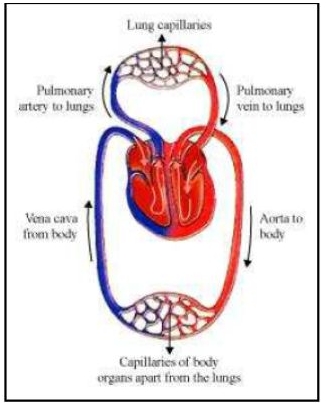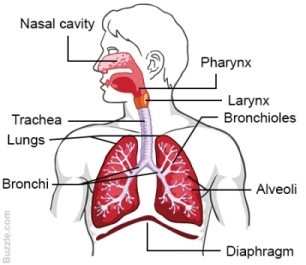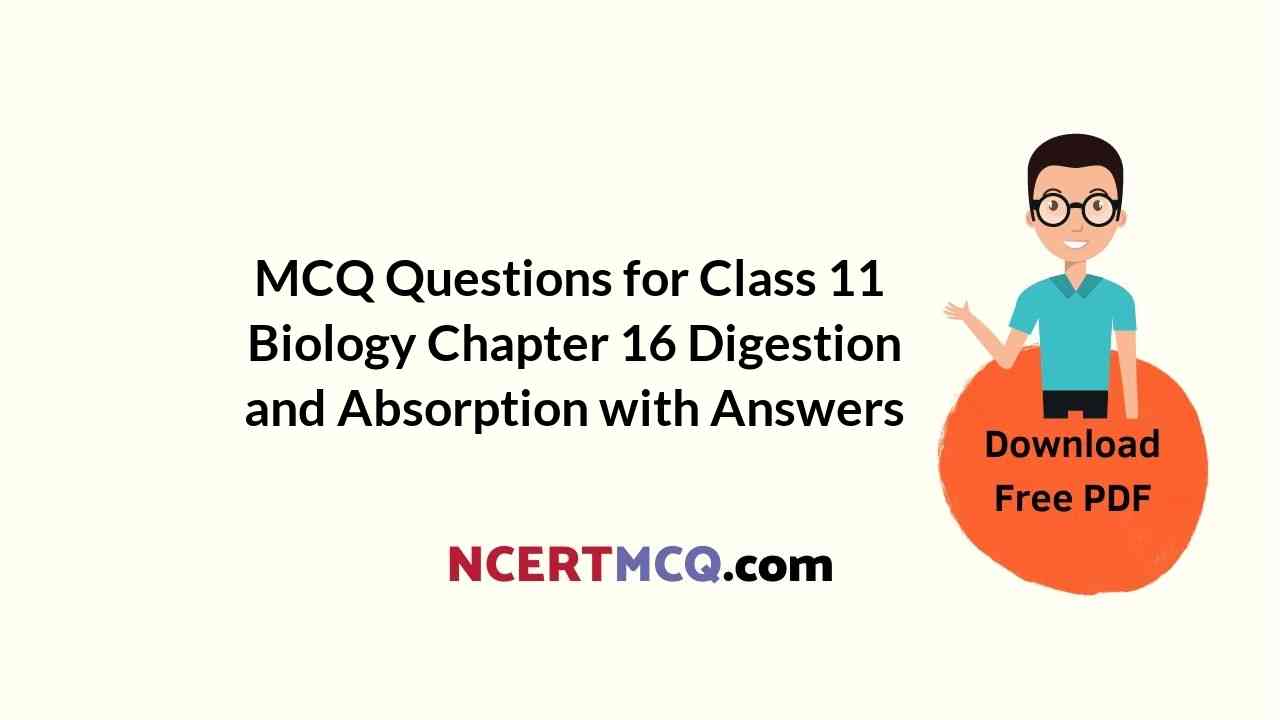Check the below NCERT MCQ Questions for Class 11 Biology Chapter 17 Breathing and Exchange of Gases with Answers Pdf free download. MCQ Questions for Class 11 Biology with Answers were prepared based on the latest exam pattern. We have provided Breathing and Exchange of Gases Class 11 Biology MCQs Questions with Answers to help students understand the concept very well.
Class 11 Biology Chapter 17 MCQ With Answers
Biology Class 11 Chapter 17 MCQs On Breathing and Exchange of Gases
Breathing And Exchange Of Gases MCQ Question 1.
The function of pneumotaxic centre is
(a) regulate inspiration
(b) regulate rhythm
(c) increase heart rate
(d) all of the above
Answer
Answer: (a) regulate inspiration
Explanation:
Pneumotaxic centre lies in pons in the brain. It regulates inspiration.
Breathing And Exchange Of Gases Class 11 MCQ Question 2.
Which one of the following is NOT correct?
(a) The nasal cavity warms and humidifies the air before it enters the lungs
(b) The right lung is composed of three lobes, but the left lung has only two lobes
(c) Lung volumes and vital capacity measure lung function.
(d) The visceral pleura is in direct contact with the chest wall.
Answer
Answer: (d) The visceral pleura is in direct contact with the chest wall.
Class 11 Biology Chapter 17 MCQ Questions Question 3.
______ lies in front of esophagus.
(a) Trachea
(b) Glottis
(c) Larynx
(d) Epiglottis
Answer
Answer: (a) Trachea
MCQ Questions On Breathing And Exchange Of Gases Class 11 Question 4.
In brain, respiratory control centre lies in
(a) pons
(b) medulla oblongata
(c) hypothalamus
(d) cerebrum
Answer
Answer: (b) medulla oblongata
Explanation:
Respiratory control centre or respiratory rhythm centre lies in medulla oblongata.
Pneumotaxic centre which lies in pons region of the brain can moderate the functions of the respiratory rhythm centre.
MCQ On Breathing And Exchange Of Gases Question 5.
Deoxygenated blood from heart comes to lungs via
(a) pulmonary vein
(b) systemic vein
(c) pulmonary artery
(d) systemic artery
Answer
Answer: (c) pulmonary artery
Explanation:

MCQ On Breathing And Exchange Of Gases Class 11 Question 6.

Label the parts of the human respiratory system.
(a) A- Oesophagus, B- Bronchioles, C- Lungs
(b) A- Trachea, B- Bronchioles, C- Lungs
(c) A- Trachea, B- Bronchus, C- Lungs
(d) A- Oesophagus, B- Bronchioles, C- Pleura
Answer
Answer: (c) A- Trachea, B- Bronchus, C- Lungs
Explanation:

Breathing And Exchange Of Gases Class 11 MCQ Pdf Download Question 7.
Pleura is a layer covering
(a) heart
(b) kidneys
(c) lungs
(d) brain
Answer
Answer: (c) lungs
Explanation:
Double layered membrane called pleura, which covers lungs in human body.
MCQ Of Breathing And Exchange Of Gases Question 8.
Rheumatic fever can cause damage
(a) Alveoli of the Lungs
(b) heart valves
(c) heart muscles
(d) pleural membranes function
Answer
Answer: (b) heart valves
MCQ Of Chapter 17 Class 11 Biology Question 9.
What protects the moist membranes of the respiratory tract?
(a) Mucus and cilia
(b) A c shaped cartilage rings
(c) A pebbly epidermal surface
(d) An acidic glands
Answer
Answer: (a) Mucus and cilia
Class 11 Breathing And Exchange Of Gases MCQ Question 10.
RBCs, plasma and biocarbonate are the medium for transport of carbondioxide. Maximum amount of carbon dioxide is carried by
(a) RBCs
(b) Plasma
(c) Bicarbonates
(d) All RBCs and bicarbonate carried 70 per cent of carbondixide.
Answer
Answer: (c) Bicarbonates
Explanation:
20-25 per cent of carbondioxide is carried by RBCs.
70 per cent is carried as bicarbonate.
7 per cent is carried in a dissolved state through plasma.
Breathing And Exchange Of Gases MCQs Question 11.
The maximum volume of air that can be released from the lungs by forceful expiration after deepest inspiration is called the ______.
(a) Total lung capacity
(b) Vital capacity
(c) Tidal volume
(d) Ventilation rate
Answer
Answer: (b) Vital capacity
MCQs On Breathing And Exchange Of Gases Question 12.
Which one of the followings is correct regarding larynx?
(a) It prevents foreign objects from entering the trachea
(b) It houses the vocal cords
(c) It is an organ made of cartilage and connects the pharynx to the trachea
(d) All of these are correct
Answer
Answer: (d) All of these are correct
Breathing And Exchange Of Gases MCQ With Answers Question 13.
Which of the following statements is true about Trachea in a respiratory system?
(a) It functions as passages of air to each alveolus
(b) It functions for sound production
(c) It Acts as passage of air to bronchi
(d) It Lowers the surface tension
Answer
Answer: (c) It Acts as passage of air to bronchi
Chapter 17 Biology Class 11 MCQ Question 14.
Which of the following statement is true?
(a) Every 100 mL of deoxygenated blood delivers approximately 4 mL of carbondioxide to the alveoli.
(b) Every 100 mL of oxygenated blood delivers approximately 4 mL of oxygen to the tissues.
(c) Every 100 mL of oxygenated blood delivers approximately 4 mL of carbondioxide to the alveoli.
(d) Every 100 mL of deoxygenated blood delivers approximately 10 mL of carbondioxide to the alveoli.
Answer
Answer: (a) Every 100 mL of deoxygenated blood delivers approximately 4 mL of carbondioxide to the alveoli.
Explanation:
Every 100 mL of deoxygenated blood delivers approximately 4 mL of carbondioxide to the alveoli.
Every 100 mL of oxygenated blood delivers approximately 5 mL of oxygen to the tissues under normal physiological conditions.
Class 11 Biology Breathing And Exchange Of Gases MCQ Question 15.
Trachea divides into bronchi at
(a) 4th thoracic vertebra
(b) 5th thoracic vertebra
(c) 6th thoracic vertebra
(d) 7th thoracic vertebra
Answer
Answer: (b) 5th thoracic vertebra
Explanation:
Trachea is a straight tube extending up to the mid-thoracic cavity. It divides into bronchi at 5th thoracic vertebra.
Question 16.
Aerobic respiratory pathway is also termed as ______ pathway.
(a) Anabolic
(b) Catabolic
(c) Creatine phosphate
(d) Amphibolic
Answer
Answer: (d) Amphibolic
Question 17.
The oxygen dissociation curve is shifted to the right by an increase in ______.
(a) H+ concentration
(b) PCO2
(c) temperature
(d) All of these
Answer
Answer: (d) All of these
Question 18.
The maximum volume of air contained in the lung by a full forced inhalation is called
(a) Vital capacity
(b) Tidal volume
(c) Total lung capacity
(d) Inspiratory capacity
Answer
Answer: (c) Total lung capacity
Question 19.
Which one of the following is NOT correct?
(a) The nasal cavity warms and humidifies the air before it enters the lungs
(b) The right lung is composed of three lobes, but the left lung has only two lobes.
(c) Lung volumes and vital capacity measure lung function.
(d) The visceral pleura is in direct contact with the chest wall.
Answer
Answer: (d) The visceral pleura is in direct contact with the chest wall.
Question 20.
Which organ lies in thoracic cavity?
(a) Heart
(b) Lungs
(c) Pancreas
(d) Both 1and 2
Answer
Answer: (d) Both 1 and 2
Explanation:
Lungs and heart both resides in thoracic cavity.
We hope the given NCERT MCQ Questions for Class 11 Biology Chapter 17 Breathing and Exchange of Gases with Answers Pdf free download will help you. If you have any queries regarding CBSE Class 11 Biology Breathing and Exchange of Gases MCQs Multiple Choice Questions with Answers, drop a comment below and we will get back to you soon.
Class 11 Biology MCQ:
- The Living World Class 11 MCQ
- Biological Classification Class 11 MCQ
- Plant Kingdom Class 11 MCQ
- Animal Kingdom Class 11 MCQ
- Morphology of Flowering Plants Class 11 MCQ
- Anatomy of Flowering Plants Class 11 MCQ
- Structural Organisation in Animals Class 11 MCQ
- Cell: The Unit of Life Class 11 MCQ
- Biomolecules Class 11 MCQ
- Cell Cycle and Cell Division Class 11 MCQ
- Transport in Plants Class 11 MCQ
- Mineral Nutrition Class 11 MCQ
- Photosynthesis in Higher Plants Class 11 MCQ
- Respiration in Plants Class 11 MCQ
- Plant Growth and Development Class 11 MCQ
- Digestion and Absorption Class 11 MCQ
- Breathing and Exchange of Gases Class 11 MCQ
- Body Fluids and Circulation Class 11 MCQ
- Excretory Products and their Elimination Class 11 MCQ
- Locomotion and Movement Class 11 MCQ
- Neural Control and Coordination Class 11 MCQ
- Chemical Coordination and Integration Class 11 MCQ
